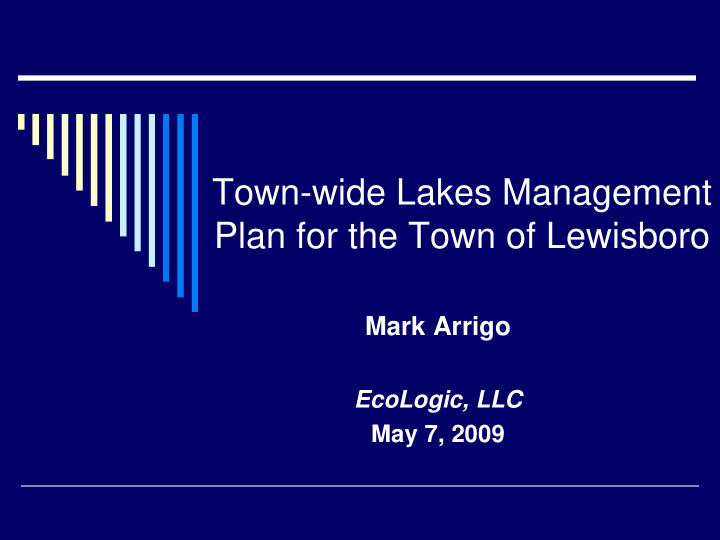



Town-wide Lakes Management Plan for the Town of Lewisboro Mark Arrigo EcoLogic, LLC May 7, 2009
Scope Summarize the water quality and aquatic habitat conditions of the Town’s Lakes Develop a unified document to protect/improve water quality Recommend specific actions
Outline Lake Ecosystems Lakes Impairment Symptoms Root causes & Sources Reductions Needed Management Options Next Steps Final Thoughts/Questions
Understanding Lake Ecosystems: The Importance of Nutrients Focus on Phosphorus Limiting nutrient in most freshwater systems Nutrients grow plants… Algae– makes the water turbid Rooted plants
Understanding Lake Ecosystems: The Importance of Nutrients Trophic State Defines the status of lakes from nutrient-poor, clear water state to nutrient-rich, very high biological productivity Eutrophication The process of moving from nutrient-poor to nutrient-rich conditions o A natural process that can be greatly accelerated by human activity
Lewisboro Lakes Impairment
Lakes Perception Summary CSLAP Perception Lakes Survey 2006 Excellent to slightly impaired; Waccabuc; Not quite crystal clear Rippowam Slightly impaired, definite algal Oscaleta “greeness” Slightly to substantially Timber; impaired Truesdale No data Kitchawan; Katonah
Lewisboro Lakes Algal Blooms Percent of Chlorophyll-a Measurements Exceeding Thresholds During Summer Period Algae in water measured by Chlorophyll-a Lake N=12 Katonah New York State Guidance Truesdale N=50 Lake Timber Lake N=21 Chloro-a > 15 ug/L = Notable Lake Impairment N=27 Waccabuc Lake N=26 Oscaleta Chloro-a >30 ug/L = Severe Impairment Lake Nuisance bloom (greater than 30 ug/l) N=26 Rippowam Perceived Impairment (greater than 15 ug/l) Lake N=2 Kitchawan* 0% 10% 20% 30% 40% 50% 60% 70% 80% Percent *Lake Kitchawan represents two samples, one collected July 2007 and one collected August 2008. Both results were less than 15 ug/l.
Pollutant of Concern Algal blooms result from excessive phosphorus phosphorus Total Phosphorus vs Chlorophyll-a June 15 - September 15 Average 50 R² = 0.9442 40 Truesdale Chlorophyll-a (ug/l) Katonah (1999-2007) (2006-2007) 30 Waccabuc Oscaleta 20 (2002-2007) (2002-2007) Timber 10 (2005-2007) Rippowam Kitchawan (2002-2007) (2007) 0 0 20 40 60 80 100 Total Phosphorus upper waters (ug/l) Lake Result Perceived Impairment (<15 ug/l) Nuisance Bloom (>30 ug/l) Linear (Lake Result)
Take Away Message to This Point Lakes are Impaired Primary Impairment is from Algae Poor water clarity Pond scum Algal blooms caused by excessive phosphorus
Where’s the Phosphorus Coming From: Primary External Sources? Sources : Land use in the watersheds Develop natural areas = >P to lakes Septics Primarily from within 100m of waterways Point sources Upstream lakes
Sources of Phosphorus: Results P from Land Use in Watershed + P from Septics + P from Point Sources = Total External Phosphorus Load
Sources of Phosphorus: Lewisboro Lakes (Average) 7% 9% 22% 62% Point sources (upstream lakes) Development Natural land cover (forest, wetlands, etc) S eptic
External Sources of Phosphorus Phosphorus Loading Estimate, Lewisboro Lakes 100% 90% 80% 70% Contribution (kg/yr) 60% 50% 40% 30% 20% 10% 0% Rippowam Oscaleta* Waccabuc Truesdale* Kitchawan Katonah Timber Point Sources (upstream lakes) Estimated Septic - 100m buffer Land Cover - Human Activity Land Cover - Natural *Septic contributions for Oscaleta and Truesdale Lakes do not include possible contributions from Connecticut, therefore these values may be underestimated.
Additional Take Away Message Septics are the primary source of phosphorus Can’t restore/protect the lakes without addressing septics issue
Phosphorus Reductions Needed • Target concentration: 20 ug/l (currently: ~22 - 98 ug/L) • NYSDEC guidance value • selected based perceived water quality impairment for recreational use to total phosphorus concentration. Very aggressive controls Reduction needed to in developed areas Lake meet 20 ug/l (ex. BMPs) Eliminate Septic Oscaleta 9% 6% 29% Rippowam 27% 4% 68% Waccabuc 28% 4% 27% Kitchawan 46% 9% 72% Timber 52% 10% 75% Truesdale 63% 13% 65% Katonah 82% 9% 84% Assumes no new sources…..
Conclusions Phosphorus is Primary Pollutant Septics are the largest contributor to P load Soils mostly not suitable for septics High density of houses near waterbodies Septic systems aging With no action eutrophication likely to accelerate Significant reductions in phosphorus loading required
Management Options 1. Do nothing 2. “Maintain” current conditions 3. Improve water quality
1. Do Nothing Rate of eutrophication will increase Septics will continue to deteriorate Nonpoint from development will increase More septics with development Sedimentation will increase End Result: greener and shallower lakes
2. “Maintain” Current Conditions Implement Code revisions Mandatory inspection/maintenance of septics Restriction on watershed development and landuse near waterbodies BMPs Focus on priority areas Retention basins (stormwater) Erosion controls Public Education End Result: Short term “stabilization” (variable) Probable long term decline
3. Improve Water Quality Significantly reduce/eliminate septic contribution Install Sewers in watersheds (Peach Lake example- next slide ) Holding tanks for more lightly populated areas Code revisions Restriction on most watershed development and landuse Restrictions on fertilizers in watershed Public Education BMPs End Result: Gradually improving water quality Timeframe for improvement variable Groundwater transport
Wastewater Treatment Peach Lake Example 1 Treatment plant : 120,000 gallons per day. New York City Watershed : requires advanced level of treatment including: ammonia removal, sand and membrane filtration, and ultraviolet disinfection. Estimated project costs: Treatment plant: $10 million Collection system: $14 million Average cost per resident $1200 per year for 30 years Compare to cost of maintaining septics… Funding: Putnam County: $2.5 million Westchester County: $10 million NYCDEP: TBD (reimburse for the tertiary level of treatment estimated to be $2.4 million)
Recommended Next Steps Convene a public educational forum(s) to discuss current water quality, and future goals for the lakes of Lewisboro. Initiate Sewer Feasibility/Cost Study Discuss creation of watershed tax districts to help fund efforts Continue the expanded annual lakes monitoring program and create a Lewisboro Lakes Report Card
Final Thoughts It took over a century to get to this point you’re not going to restore the lakes overnight This will not be easy or inexpensive It will require long term planning and commitment from the community With community support, it can be done!
Questions? Thank you,
Recommend
More recommend